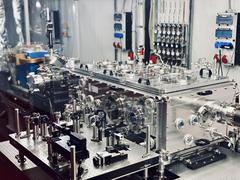URL: https://www.desy.de/news/news_search/index_eng.html
Breadcrumb Navigation
DESY News: 100 shots per second
News
News from the DESY research centre
100 shots per second
Laser-plasma accelerators can accelerate particles over distances that are up to 1000 times shorter than those required by conventional accelerators. The technology promises compact systems that have enormous potential to open up new applications for accelerators, for example in medicine or industry. However, the current prototypes have one drawback: most can only accelerate a few particle bunches per second – not enough for practical applications. DESY’s new flagship laser KALDERA has now made a decisive step forward: driving the compact plasma accelerator MAGMA, the innovative laser has shown to accelerate 100 particle bunches per second. This increased repetition rate opens the path to actively stabilise the plasma accelerator performance in the future which will bring it a good deal closer to first applications.

Amplifier of the KALDERA laser system: The laser energy is increased by transferring energy of green pump laser pulses to KALDERA laser pulses. Photo: DESY, Juan B. Gonzalez
The technique could significantly reduce the size of accelerators: a hundred-metre-long facility could be replaced by a machine that fits inside a basement laboratory. ‘This would make it possible to build more cost-effective machines, for example free-electron lasers,’ points out Andreas Maier, lead scientist for plasma acceleration at DESY. Several prototypes have already demonstrated the viability of the technique, also at DESY: ‘We were the first in the world to successfully run a laser-plasma accelerator for more than 24 hours,’ explains Maier. ‘It accelerated electrons once every second.’ But this is certainly not enough for practical applications: the viable operation of an FEL requires several hundred to thousands shots per second.
This is the goal which the team of researchers behind KALDERA is pursuing: ‘In the future, this new laser is meant to accelerate up to a thousand electron bunches per second,’ says Manuel Kirchen, Team Leader for High-Average Power Laser Plasma Acceleration in DESY’s Plasma Group. ‘That would make the technology competitive.’ The set-up is based on a technology in which a special laser first generates weak but very short pulses of light. These pulses are then directed into crystals that have previously been charged with energy by pump lasers and now transfer this energy to the light pulses. They are followed by further light amplifiers, with each stage increasing the energy of the pulses. To prevent the increasingly powerful pulses from destroying the system, they are stretched to several times of their original length using a special optical system. The elongated pulses can then be amplified further without damaging the optics. After the final amplification, they are squeezed together again by a so-called compressor. ‘Its surface consists of thin layers which have a fine lattice structure,’ explains Guido Palmer, Head of Laser Development in DESY’s plasma group. ‘These absorb less heat than the gold coatings that were used in the past and enable a new compressor design that is key to the operation of KALDERA.’ The resulting laser pulses that leave the apparatus are short and extremely powerful.
On the initiative of Accelerator Division Director Wim Leemans, the team began building KALDERA in 2020, which has now gone into operation for the first time – and immediately achieved a remarkable success. ‘Already on the first try, we were able to accelerate 100 electron bunches per second,’ says Kirchen. ‘This is the basis for significantly improving the quality of the electron bunches through active stabilisation.’ At the moment, vibrations, air fluctuations, or instabilities in the power grid can severely disrupt the particle bunches and adversely affect their properties. ‘When the air moves, the laser beam also moves,’ adds Palmer. ‘This can result in individual electron bunches having different intensities or energy distributions.’

The MAGMA plasma accelerator driven by DESY’s flagship laser KALDERA: Electrons are accelerated on a few millimeters with 100 shots per second. Photo: DESY, Sören Jalas
The KALDERA team has already started to upgrade the laser energy, which will enable higher electron beam energies in the future. Further improvements should be possible in the coming months and years as the experts gradually implement their ideas for feedback and control in the system. ‘With these measures, we hope to reach the ultimate goal of KALDERA in a few years’ time,’ says Leemans. ‘We want to realise a laser-plasma accelerator that produces 1000 high-quality electron bunches per second.’
More information on KALDERA can be found here: https://kaldera.desy.de/



